Professional Accountability and Patient Safety Case Study 2022
VerifiedAdded on 2022/09/26
|9
|2493
|25
AI Summary
Contribute Materials
Your contribution can guide someone’s learning journey. Share your
documents today.
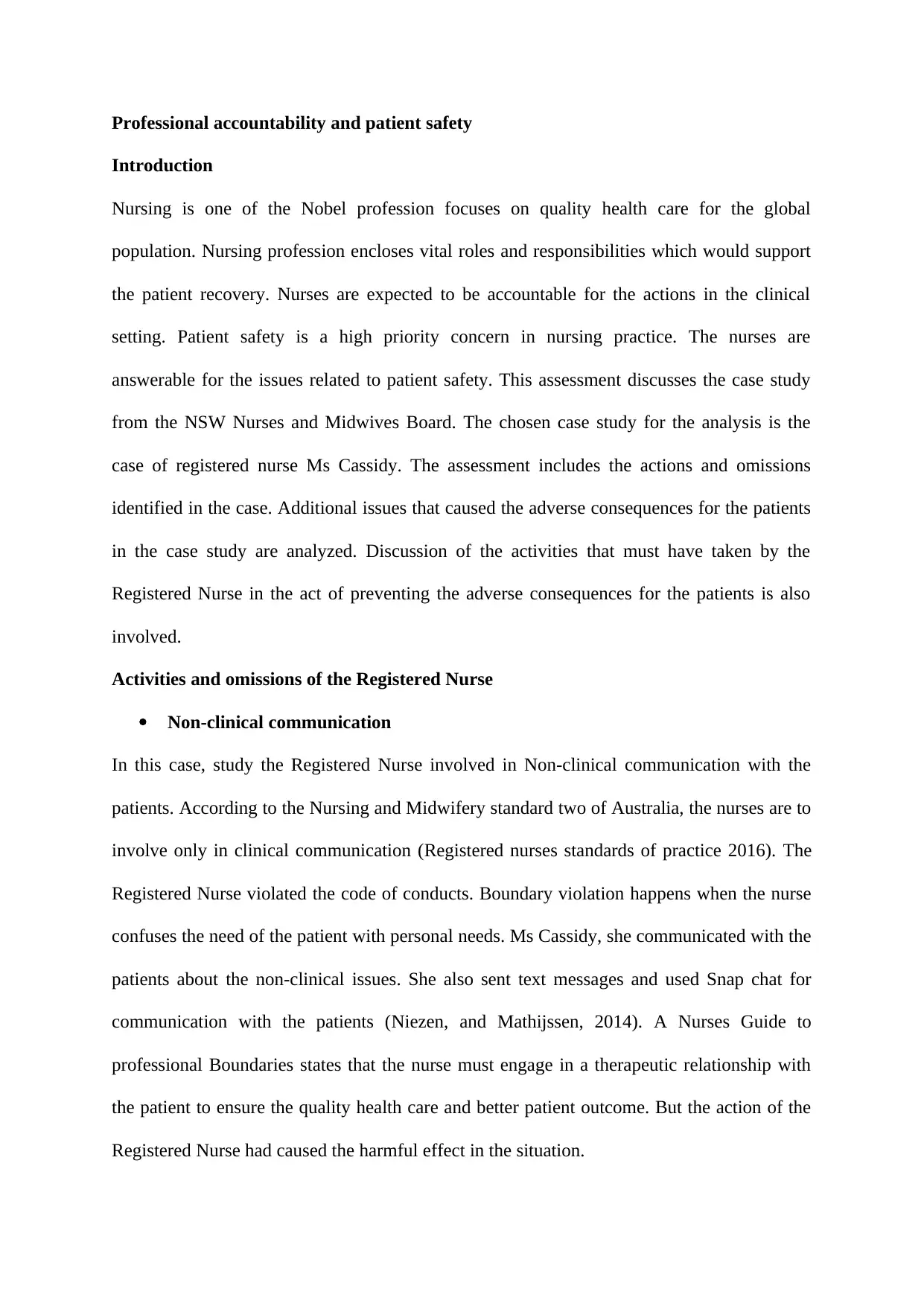
Professional accountability and patient safety
Introduction
Nursing is one of the Nobel profession focuses on quality health care for the global
population. Nursing profession encloses vital roles and responsibilities which would support
the patient recovery. Nurses are expected to be accountable for the actions in the clinical
setting. Patient safety is a high priority concern in nursing practice. The nurses are
answerable for the issues related to patient safety. This assessment discusses the case study
from the NSW Nurses and Midwives Board. The chosen case study for the analysis is the
case of registered nurse Ms Cassidy. The assessment includes the actions and omissions
identified in the case. Additional issues that caused the adverse consequences for the patients
in the case study are analyzed. Discussion of the activities that must have taken by the
Registered Nurse in the act of preventing the adverse consequences for the patients is also
involved.
Activities and omissions of the Registered Nurse
Non-clinical communication
In this case, study the Registered Nurse involved in Non-clinical communication with the
patients. According to the Nursing and Midwifery standard two of Australia, the nurses are to
involve only in clinical communication (Registered nurses standards of practice 2016). The
Registered Nurse violated the code of conducts. Boundary violation happens when the nurse
confuses the need of the patient with personal needs. Ms Cassidy, she communicated with the
patients about the non-clinical issues. She also sent text messages and used Snap chat for
communication with the patients (Niezen, and Mathijssen, 2014). A Nurses Guide to
professional Boundaries states that the nurse must engage in a therapeutic relationship with
the patient to ensure the quality health care and better patient outcome. But the action of the
Registered Nurse had caused the harmful effect in the situation.
Introduction
Nursing is one of the Nobel profession focuses on quality health care for the global
population. Nursing profession encloses vital roles and responsibilities which would support
the patient recovery. Nurses are expected to be accountable for the actions in the clinical
setting. Patient safety is a high priority concern in nursing practice. The nurses are
answerable for the issues related to patient safety. This assessment discusses the case study
from the NSW Nurses and Midwives Board. The chosen case study for the analysis is the
case of registered nurse Ms Cassidy. The assessment includes the actions and omissions
identified in the case. Additional issues that caused the adverse consequences for the patients
in the case study are analyzed. Discussion of the activities that must have taken by the
Registered Nurse in the act of preventing the adverse consequences for the patients is also
involved.
Activities and omissions of the Registered Nurse
Non-clinical communication
In this case, study the Registered Nurse involved in Non-clinical communication with the
patients. According to the Nursing and Midwifery standard two of Australia, the nurses are to
involve only in clinical communication (Registered nurses standards of practice 2016). The
Registered Nurse violated the code of conducts. Boundary violation happens when the nurse
confuses the need of the patient with personal needs. Ms Cassidy, she communicated with the
patients about the non-clinical issues. She also sent text messages and used Snap chat for
communication with the patients (Niezen, and Mathijssen, 2014). A Nurses Guide to
professional Boundaries states that the nurse must engage in a therapeutic relationship with
the patient to ensure the quality health care and better patient outcome. But the action of the
Registered Nurse had caused the harmful effect in the situation.
Secure Best Marks with AI Grader
Need help grading? Try our AI Grader for instant feedback on your assignments.
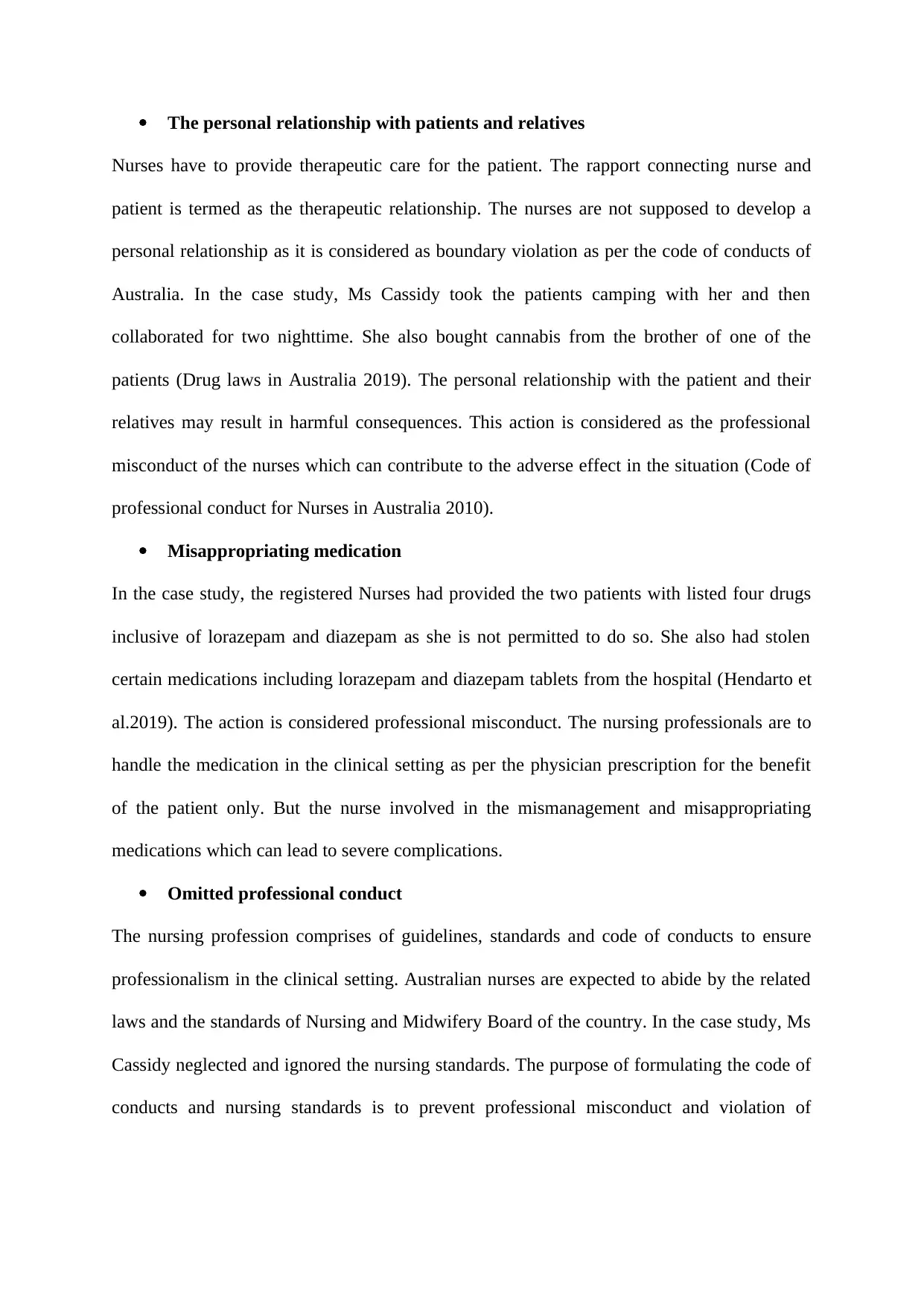
The personal relationship with patients and relatives
Nurses have to provide therapeutic care for the patient. The rapport connecting nurse and
patient is termed as the therapeutic relationship. The nurses are not supposed to develop a
personal relationship as it is considered as boundary violation as per the code of conducts of
Australia. In the case study, Ms Cassidy took the patients camping with her and then
collaborated for two nighttime. She also bought cannabis from the brother of one of the
patients (Drug laws in Australia 2019). The personal relationship with the patient and their
relatives may result in harmful consequences. This action is considered as the professional
misconduct of the nurses which can contribute to the adverse effect in the situation (Code of
professional conduct for Nurses in Australia 2010).
Misappropriating medication
In the case study, the registered Nurses had provided the two patients with listed four drugs
inclusive of lorazepam and diazepam as she is not permitted to do so. She also had stolen
certain medications including lorazepam and diazepam tablets from the hospital (Hendarto et
al.2019). The action is considered professional misconduct. The nursing professionals are to
handle the medication in the clinical setting as per the physician prescription for the benefit
of the patient only. But the nurse involved in the mismanagement and misappropriating
medications which can lead to severe complications.
Omitted professional conduct
The nursing profession comprises of guidelines, standards and code of conducts to ensure
professionalism in the clinical setting. Australian nurses are expected to abide by the related
laws and the standards of Nursing and Midwifery Board of the country. In the case study, Ms
Cassidy neglected and ignored the nursing standards. The purpose of formulating the code of
conducts and nursing standards is to prevent professional misconduct and violation of
Nurses have to provide therapeutic care for the patient. The rapport connecting nurse and
patient is termed as the therapeutic relationship. The nurses are not supposed to develop a
personal relationship as it is considered as boundary violation as per the code of conducts of
Australia. In the case study, Ms Cassidy took the patients camping with her and then
collaborated for two nighttime. She also bought cannabis from the brother of one of the
patients (Drug laws in Australia 2019). The personal relationship with the patient and their
relatives may result in harmful consequences. This action is considered as the professional
misconduct of the nurses which can contribute to the adverse effect in the situation (Code of
professional conduct for Nurses in Australia 2010).
Misappropriating medication
In the case study, the registered Nurses had provided the two patients with listed four drugs
inclusive of lorazepam and diazepam as she is not permitted to do so. She also had stolen
certain medications including lorazepam and diazepam tablets from the hospital (Hendarto et
al.2019). The action is considered professional misconduct. The nursing professionals are to
handle the medication in the clinical setting as per the physician prescription for the benefit
of the patient only. But the nurse involved in the mismanagement and misappropriating
medications which can lead to severe complications.
Omitted professional conduct
The nursing profession comprises of guidelines, standards and code of conducts to ensure
professionalism in the clinical setting. Australian nurses are expected to abide by the related
laws and the standards of Nursing and Midwifery Board of the country. In the case study, Ms
Cassidy neglected and ignored the nursing standards. The purpose of formulating the code of
conducts and nursing standards is to prevent professional misconduct and violation of
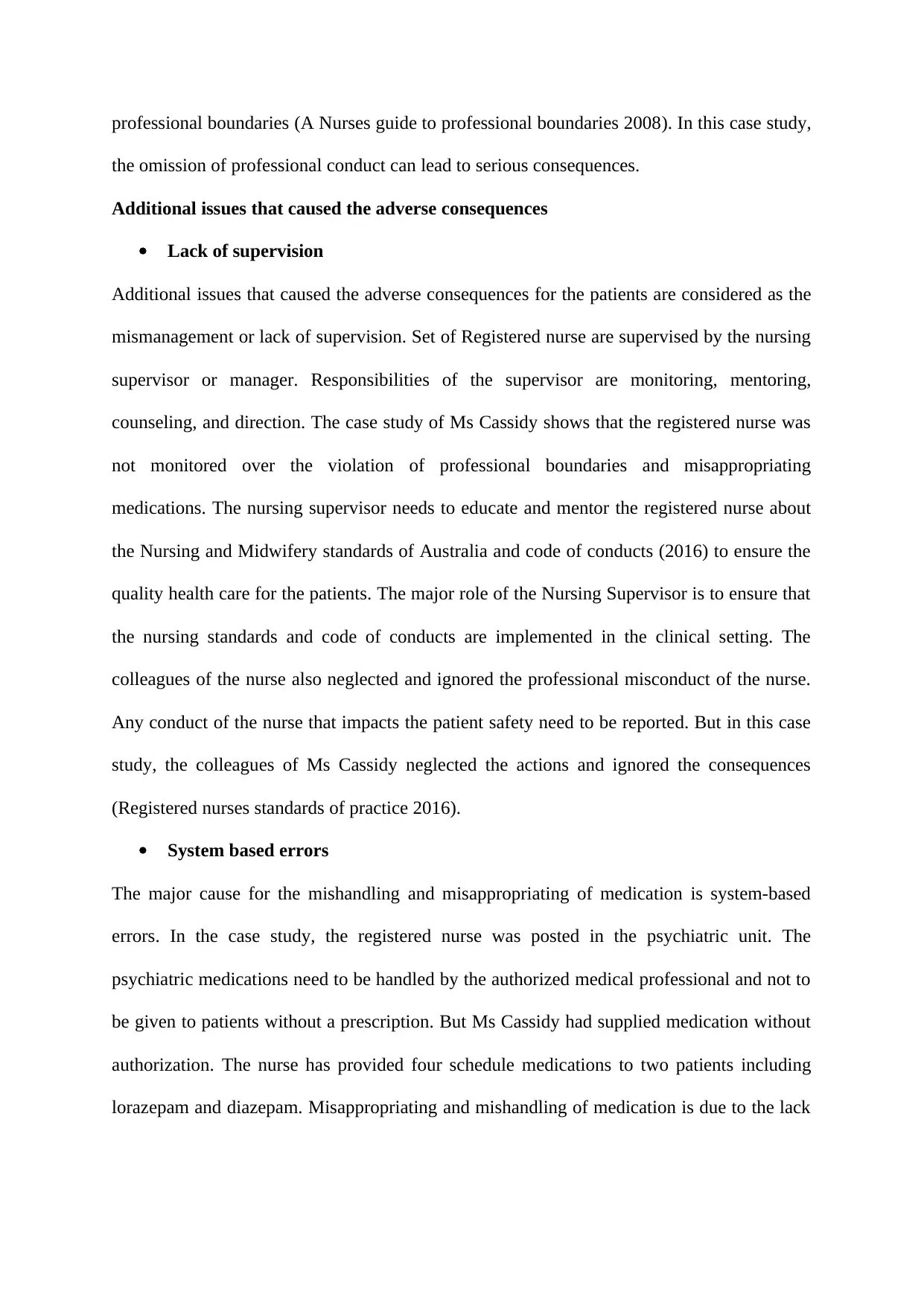
professional boundaries (A Nurses guide to professional boundaries 2008). In this case study,
the omission of professional conduct can lead to serious consequences.
Additional issues that caused the adverse consequences
Lack of supervision
Additional issues that caused the adverse consequences for the patients are considered as the
mismanagement or lack of supervision. Set of Registered nurse are supervised by the nursing
supervisor or manager. Responsibilities of the supervisor are monitoring, mentoring,
counseling, and direction. The case study of Ms Cassidy shows that the registered nurse was
not monitored over the violation of professional boundaries and misappropriating
medications. The nursing supervisor needs to educate and mentor the registered nurse about
the Nursing and Midwifery standards of Australia and code of conducts (2016) to ensure the
quality health care for the patients. The major role of the Nursing Supervisor is to ensure that
the nursing standards and code of conducts are implemented in the clinical setting. The
colleagues of the nurse also neglected and ignored the professional misconduct of the nurse.
Any conduct of the nurse that impacts the patient safety need to be reported. But in this case
study, the colleagues of Ms Cassidy neglected the actions and ignored the consequences
(Registered nurses standards of practice 2016).
System based errors
The major cause for the mishandling and misappropriating of medication is system-based
errors. In the case study, the registered nurse was posted in the psychiatric unit. The
psychiatric medications need to be handled by the authorized medical professional and not to
be given to patients without a prescription. But Ms Cassidy had supplied medication without
authorization. The nurse has provided four schedule medications to two patients including
lorazepam and diazepam. Misappropriating and mishandling of medication is due to the lack
the omission of professional conduct can lead to serious consequences.
Additional issues that caused the adverse consequences
Lack of supervision
Additional issues that caused the adverse consequences for the patients are considered as the
mismanagement or lack of supervision. Set of Registered nurse are supervised by the nursing
supervisor or manager. Responsibilities of the supervisor are monitoring, mentoring,
counseling, and direction. The case study of Ms Cassidy shows that the registered nurse was
not monitored over the violation of professional boundaries and misappropriating
medications. The nursing supervisor needs to educate and mentor the registered nurse about
the Nursing and Midwifery standards of Australia and code of conducts (2016) to ensure the
quality health care for the patients. The major role of the Nursing Supervisor is to ensure that
the nursing standards and code of conducts are implemented in the clinical setting. The
colleagues of the nurse also neglected and ignored the professional misconduct of the nurse.
Any conduct of the nurse that impacts the patient safety need to be reported. But in this case
study, the colleagues of Ms Cassidy neglected the actions and ignored the consequences
(Registered nurses standards of practice 2016).
System based errors
The major cause for the mishandling and misappropriating of medication is system-based
errors. In the case study, the registered nurse was posted in the psychiatric unit. The
psychiatric medications need to be handled by the authorized medical professional and not to
be given to patients without a prescription. But Ms Cassidy had supplied medication without
authorization. The nurse has provided four schedule medications to two patients including
lorazepam and diazepam. Misappropriating and mishandling of medication is due to the lack
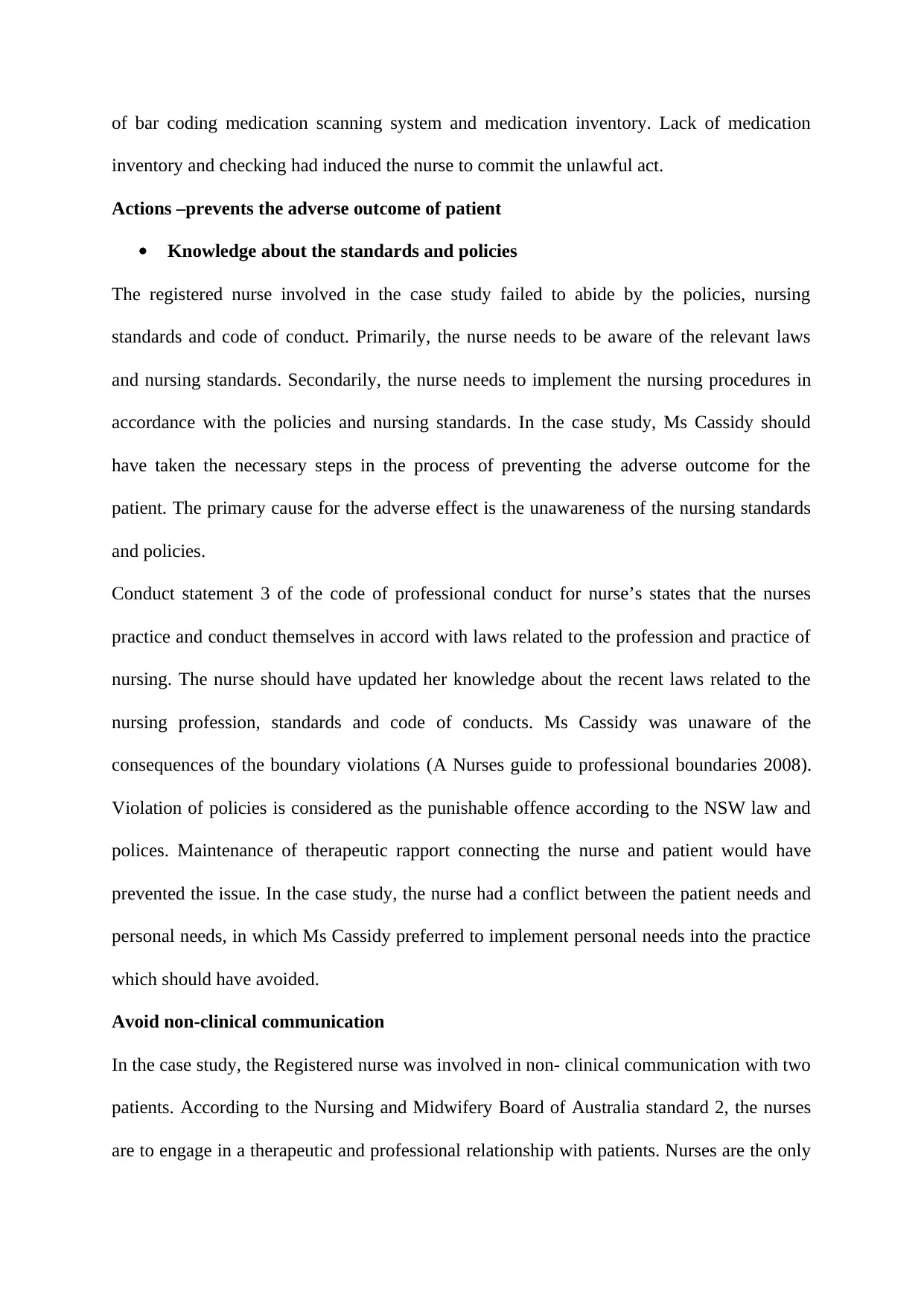
of bar coding medication scanning system and medication inventory. Lack of medication
inventory and checking had induced the nurse to commit the unlawful act.
Actions –prevents the adverse outcome of patient
Knowledge about the standards and policies
The registered nurse involved in the case study failed to abide by the policies, nursing
standards and code of conduct. Primarily, the nurse needs to be aware of the relevant laws
and nursing standards. Secondarily, the nurse needs to implement the nursing procedures in
accordance with the policies and nursing standards. In the case study, Ms Cassidy should
have taken the necessary steps in the process of preventing the adverse outcome for the
patient. The primary cause for the adverse effect is the unawareness of the nursing standards
and policies.
Conduct statement 3 of the code of professional conduct for nurse’s states that the nurses
practice and conduct themselves in accord with laws related to the profession and practice of
nursing. The nurse should have updated her knowledge about the recent laws related to the
nursing profession, standards and code of conducts. Ms Cassidy was unaware of the
consequences of the boundary violations (A Nurses guide to professional boundaries 2008).
Violation of policies is considered as the punishable offence according to the NSW law and
polices. Maintenance of therapeutic rapport connecting the nurse and patient would have
prevented the issue. In the case study, the nurse had a conflict between the patient needs and
personal needs, in which Ms Cassidy preferred to implement personal needs into the practice
which should have avoided.
Avoid non-clinical communication
In the case study, the Registered nurse was involved in non- clinical communication with two
patients. According to the Nursing and Midwifery Board of Australia standard 2, the nurses
are to engage in a therapeutic and professional relationship with patients. Nurses are the only
inventory and checking had induced the nurse to commit the unlawful act.
Actions –prevents the adverse outcome of patient
Knowledge about the standards and policies
The registered nurse involved in the case study failed to abide by the policies, nursing
standards and code of conduct. Primarily, the nurse needs to be aware of the relevant laws
and nursing standards. Secondarily, the nurse needs to implement the nursing procedures in
accordance with the policies and nursing standards. In the case study, Ms Cassidy should
have taken the necessary steps in the process of preventing the adverse outcome for the
patient. The primary cause for the adverse effect is the unawareness of the nursing standards
and policies.
Conduct statement 3 of the code of professional conduct for nurse’s states that the nurses
practice and conduct themselves in accord with laws related to the profession and practice of
nursing. The nurse should have updated her knowledge about the recent laws related to the
nursing profession, standards and code of conducts. Ms Cassidy was unaware of the
consequences of the boundary violations (A Nurses guide to professional boundaries 2008).
Violation of policies is considered as the punishable offence according to the NSW law and
polices. Maintenance of therapeutic rapport connecting the nurse and patient would have
prevented the issue. In the case study, the nurse had a conflict between the patient needs and
personal needs, in which Ms Cassidy preferred to implement personal needs into the practice
which should have avoided.
Avoid non-clinical communication
In the case study, the Registered nurse was involved in non- clinical communication with two
patients. According to the Nursing and Midwifery Board of Australia standard 2, the nurses
are to engage in a therapeutic and professional relationship with patients. Nurses are the only
Secure Best Marks with AI Grader
Need help grading? Try our AI Grader for instant feedback on your assignments.
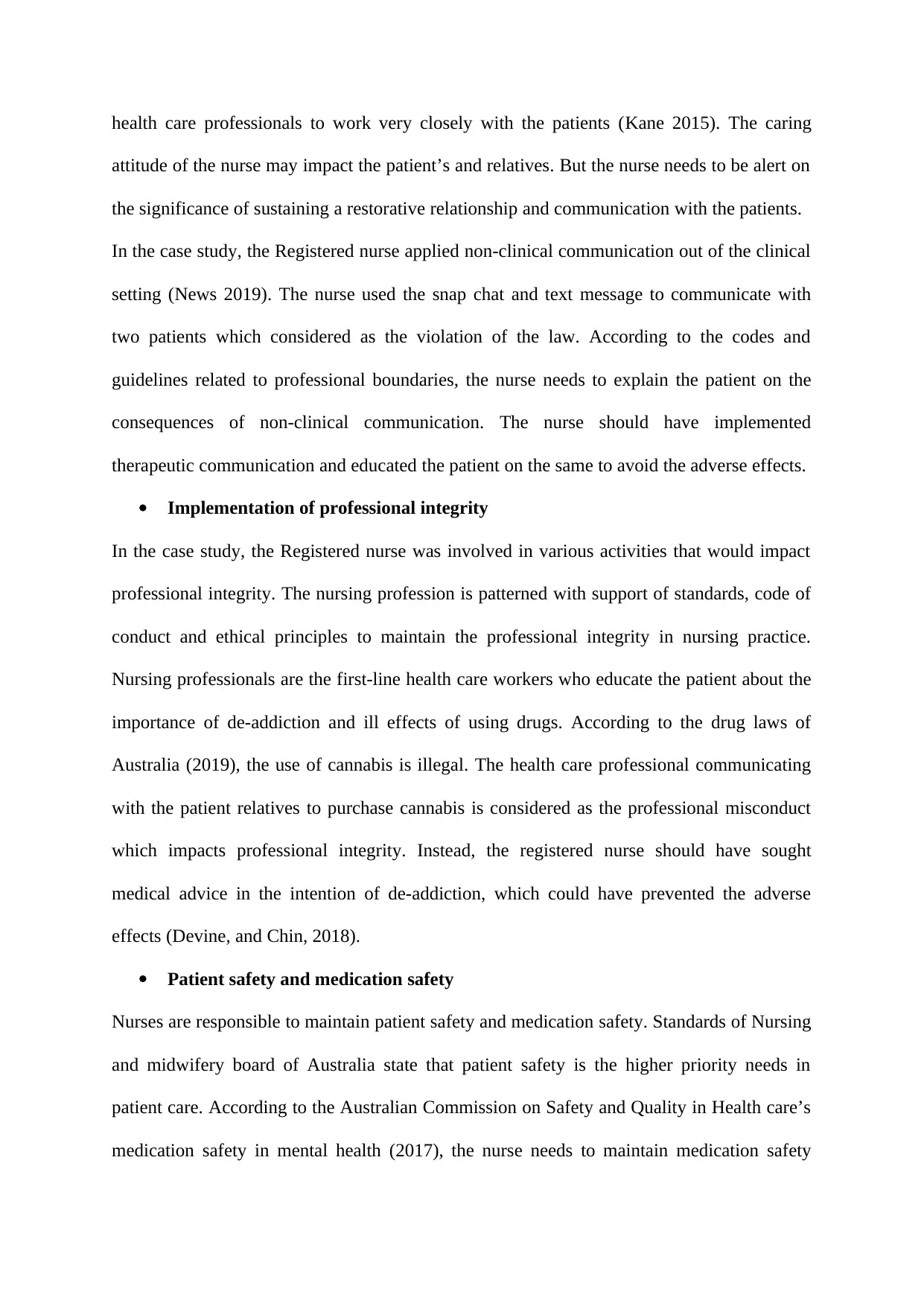
health care professionals to work very closely with the patients (Kane 2015). The caring
attitude of the nurse may impact the patient’s and relatives. But the nurse needs to be alert on
the significance of sustaining a restorative relationship and communication with the patients.
In the case study, the Registered nurse applied non-clinical communication out of the clinical
setting (News 2019). The nurse used the snap chat and text message to communicate with
two patients which considered as the violation of the law. According to the codes and
guidelines related to professional boundaries, the nurse needs to explain the patient on the
consequences of non-clinical communication. The nurse should have implemented
therapeutic communication and educated the patient on the same to avoid the adverse effects.
Implementation of professional integrity
In the case study, the Registered nurse was involved in various activities that would impact
professional integrity. The nursing profession is patterned with support of standards, code of
conduct and ethical principles to maintain the professional integrity in nursing practice.
Nursing professionals are the first-line health care workers who educate the patient about the
importance of de-addiction and ill effects of using drugs. According to the drug laws of
Australia (2019), the use of cannabis is illegal. The health care professional communicating
with the patient relatives to purchase cannabis is considered as the professional misconduct
which impacts professional integrity. Instead, the registered nurse should have sought
medical advice in the intention of de-addiction, which could have prevented the adverse
effects (Devine, and Chin, 2018).
Patient safety and medication safety
Nurses are responsible to maintain patient safety and medication safety. Standards of Nursing
and midwifery board of Australia state that patient safety is the higher priority needs in
patient care. According to the Australian Commission on Safety and Quality in Health care’s
medication safety in mental health (2017), the nurse needs to maintain medication safety
attitude of the nurse may impact the patient’s and relatives. But the nurse needs to be alert on
the significance of sustaining a restorative relationship and communication with the patients.
In the case study, the Registered nurse applied non-clinical communication out of the clinical
setting (News 2019). The nurse used the snap chat and text message to communicate with
two patients which considered as the violation of the law. According to the codes and
guidelines related to professional boundaries, the nurse needs to explain the patient on the
consequences of non-clinical communication. The nurse should have implemented
therapeutic communication and educated the patient on the same to avoid the adverse effects.
Implementation of professional integrity
In the case study, the Registered nurse was involved in various activities that would impact
professional integrity. The nursing profession is patterned with support of standards, code of
conduct and ethical principles to maintain the professional integrity in nursing practice.
Nursing professionals are the first-line health care workers who educate the patient about the
importance of de-addiction and ill effects of using drugs. According to the drug laws of
Australia (2019), the use of cannabis is illegal. The health care professional communicating
with the patient relatives to purchase cannabis is considered as the professional misconduct
which impacts professional integrity. Instead, the registered nurse should have sought
medical advice in the intention of de-addiction, which could have prevented the adverse
effects (Devine, and Chin, 2018).
Patient safety and medication safety
Nurses are responsible to maintain patient safety and medication safety. Standards of Nursing
and midwifery board of Australia state that patient safety is the higher priority needs in
patient care. According to the Australian Commission on Safety and Quality in Health care’s
medication safety in mental health (2017), the nurse needs to maintain medication safety
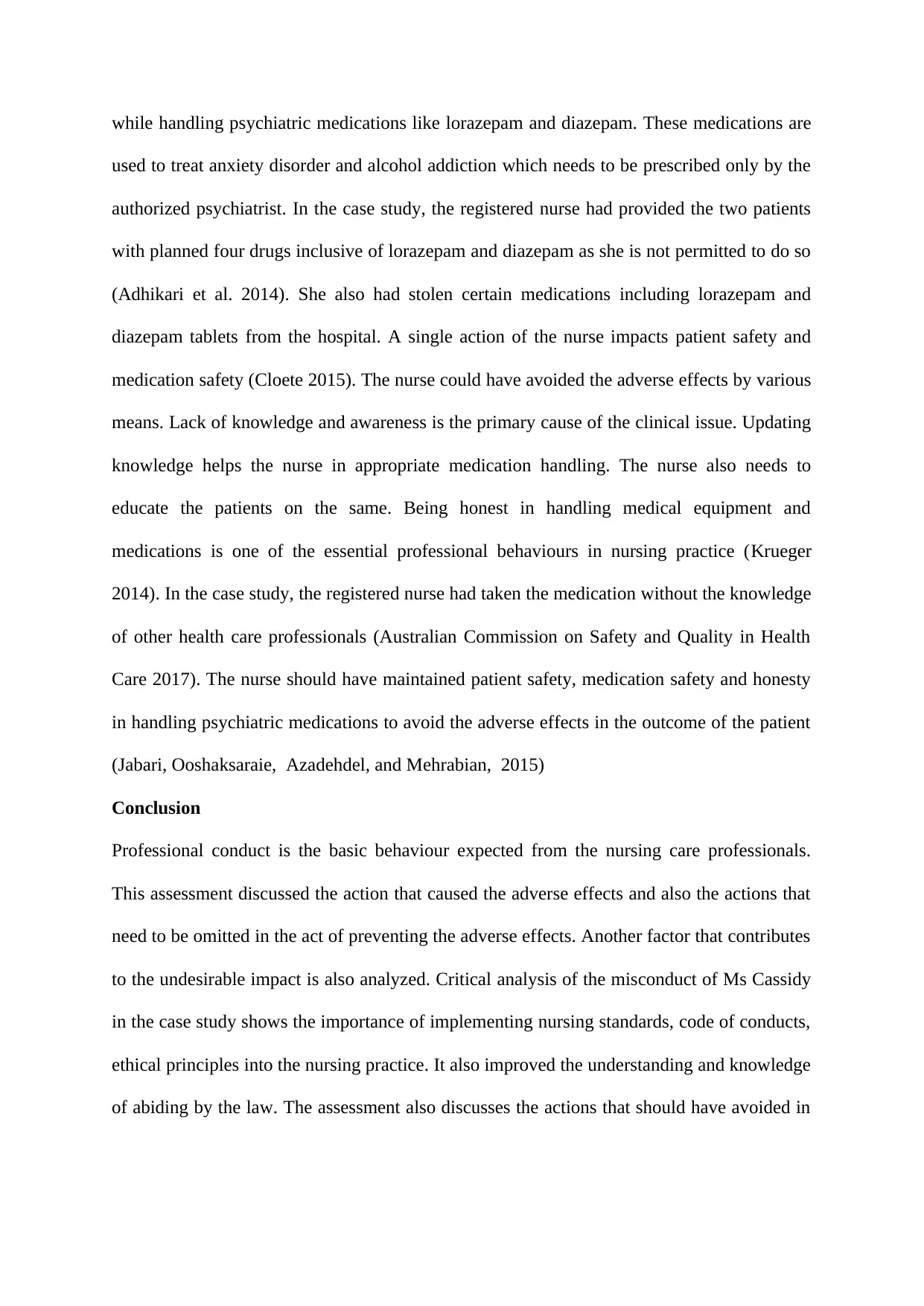
while handling psychiatric medications like lorazepam and diazepam. These medications are
used to treat anxiety disorder and alcohol addiction which needs to be prescribed only by the
authorized psychiatrist. In the case study, the registered nurse had provided the two patients
with planned four drugs inclusive of lorazepam and diazepam as she is not permitted to do so
(Adhikari et al. 2014). She also had stolen certain medications including lorazepam and
diazepam tablets from the hospital. A single action of the nurse impacts patient safety and
medication safety (Cloete 2015). The nurse could have avoided the adverse effects by various
means. Lack of knowledge and awareness is the primary cause of the clinical issue. Updating
knowledge helps the nurse in appropriate medication handling. The nurse also needs to
educate the patients on the same. Being honest in handling medical equipment and
medications is one of the essential professional behaviours in nursing practice (Krueger
2014). In the case study, the registered nurse had taken the medication without the knowledge
of other health care professionals (Australian Commission on Safety and Quality in Health
Care 2017). The nurse should have maintained patient safety, medication safety and honesty
in handling psychiatric medications to avoid the adverse effects in the outcome of the patient
(Jabari, Ooshaksaraie, Azadehdel, and Mehrabian, 2015)
Conclusion
Professional conduct is the basic behaviour expected from the nursing care professionals.
This assessment discussed the action that caused the adverse effects and also the actions that
need to be omitted in the act of preventing the adverse effects. Another factor that contributes
to the undesirable impact is also analyzed. Critical analysis of the misconduct of Ms Cassidy
in the case study shows the importance of implementing nursing standards, code of conducts,
ethical principles into the nursing practice. It also improved the understanding and knowledge
of abiding by the law. The assessment also discusses the actions that should have avoided in
used to treat anxiety disorder and alcohol addiction which needs to be prescribed only by the
authorized psychiatrist. In the case study, the registered nurse had provided the two patients
with planned four drugs inclusive of lorazepam and diazepam as she is not permitted to do so
(Adhikari et al. 2014). She also had stolen certain medications including lorazepam and
diazepam tablets from the hospital. A single action of the nurse impacts patient safety and
medication safety (Cloete 2015). The nurse could have avoided the adverse effects by various
means. Lack of knowledge and awareness is the primary cause of the clinical issue. Updating
knowledge helps the nurse in appropriate medication handling. The nurse also needs to
educate the patients on the same. Being honest in handling medical equipment and
medications is one of the essential professional behaviours in nursing practice (Krueger
2014). In the case study, the registered nurse had taken the medication without the knowledge
of other health care professionals (Australian Commission on Safety and Quality in Health
Care 2017). The nurse should have maintained patient safety, medication safety and honesty
in handling psychiatric medications to avoid the adverse effects in the outcome of the patient
(Jabari, Ooshaksaraie, Azadehdel, and Mehrabian, 2015)
Conclusion
Professional conduct is the basic behaviour expected from the nursing care professionals.
This assessment discussed the action that caused the adverse effects and also the actions that
need to be omitted in the act of preventing the adverse effects. Another factor that contributes
to the undesirable impact is also analyzed. Critical analysis of the misconduct of Ms Cassidy
in the case study shows the importance of implementing nursing standards, code of conducts,
ethical principles into the nursing practice. It also improved the understanding and knowledge
of abiding by the law. The assessment also discusses the actions that should have avoided in
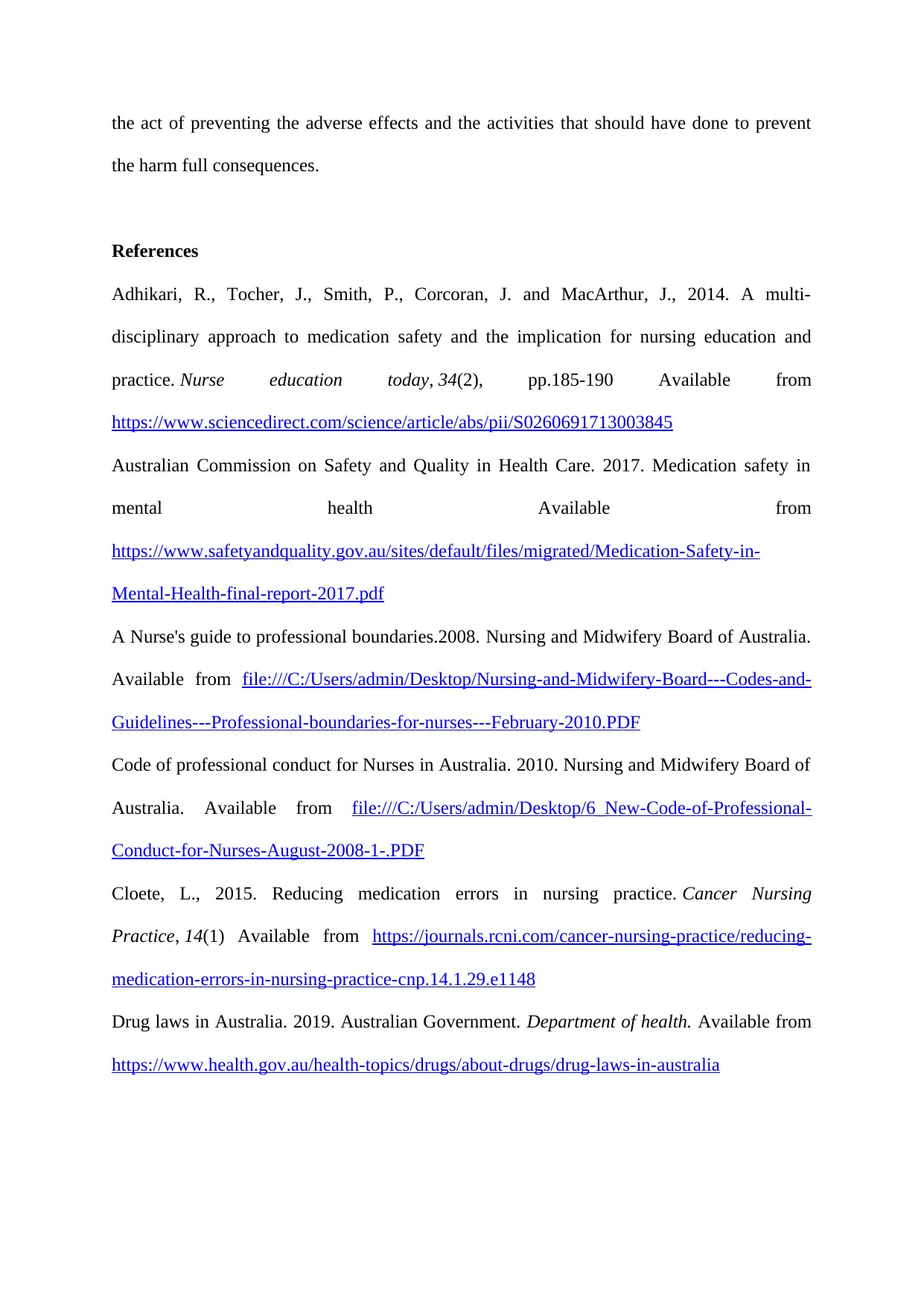
the act of preventing the adverse effects and the activities that should have done to prevent
the harm full consequences.
References
Adhikari, R., Tocher, J., Smith, P., Corcoran, J. and MacArthur, J., 2014. A multi-
disciplinary approach to medication safety and the implication for nursing education and
practice. Nurse education today, 34(2), pp.185-190 Available from
https://www.sciencedirect.com/science/article/abs/pii/S0260691713003845
Australian Commission on Safety and Quality in Health Care. 2017. Medication safety in
mental health Available from
https://www.safetyandquality.gov.au/sites/default/files/migrated/Medication-Safety-in-
Mental-Health-final-report-2017.pdf
A Nurse's guide to professional boundaries.2008. Nursing and Midwifery Board of Australia.
Available from file:///C:/Users/admin/Desktop/Nursing-and-Midwifery-Board---Codes-and-
Guidelines---Professional-boundaries-for-nurses---February-2010.PDF
Code of professional conduct for Nurses in Australia. 2010. Nursing and Midwifery Board of
Australia. Available from file:///C:/Users/admin/Desktop/6_New-Code-of-Professional-
Conduct-for-Nurses-August-2008-1-.PDF
Cloete, L., 2015. Reducing medication errors in nursing practice. Cancer Nursing
Practice, 14(1) Available from https://journals.rcni.com/cancer-nursing-practice/reducing-
medication-errors-in-nursing-practice-cnp.14.1.29.e1148
Drug laws in Australia. 2019. Australian Government. Department of health. Available from
https://www.health.gov.au/health-topics/drugs/about-drugs/drug-laws-in-australia
the harm full consequences.
References
Adhikari, R., Tocher, J., Smith, P., Corcoran, J. and MacArthur, J., 2014. A multi-
disciplinary approach to medication safety and the implication for nursing education and
practice. Nurse education today, 34(2), pp.185-190 Available from
https://www.sciencedirect.com/science/article/abs/pii/S0260691713003845
Australian Commission on Safety and Quality in Health Care. 2017. Medication safety in
mental health Available from
https://www.safetyandquality.gov.au/sites/default/files/migrated/Medication-Safety-in-
Mental-Health-final-report-2017.pdf
A Nurse's guide to professional boundaries.2008. Nursing and Midwifery Board of Australia.
Available from file:///C:/Users/admin/Desktop/Nursing-and-Midwifery-Board---Codes-and-
Guidelines---Professional-boundaries-for-nurses---February-2010.PDF
Code of professional conduct for Nurses in Australia. 2010. Nursing and Midwifery Board of
Australia. Available from file:///C:/Users/admin/Desktop/6_New-Code-of-Professional-
Conduct-for-Nurses-August-2008-1-.PDF
Cloete, L., 2015. Reducing medication errors in nursing practice. Cancer Nursing
Practice, 14(1) Available from https://journals.rcni.com/cancer-nursing-practice/reducing-
medication-errors-in-nursing-practice-cnp.14.1.29.e1148
Drug laws in Australia. 2019. Australian Government. Department of health. Available from
https://www.health.gov.au/health-topics/drugs/about-drugs/drug-laws-in-australia
Paraphrase This Document
Need a fresh take? Get an instant paraphrase of this document with our AI Paraphraser
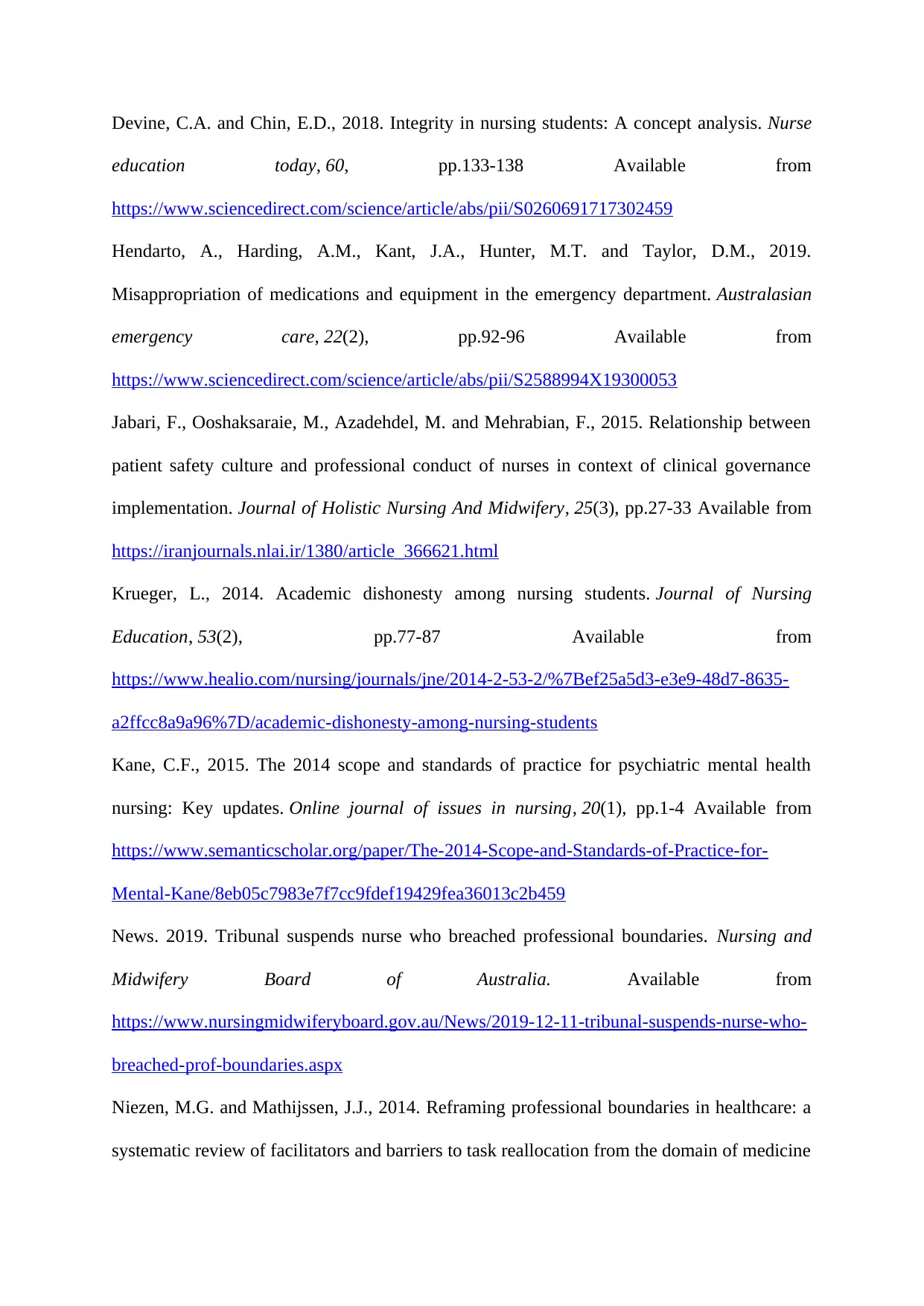
Devine, C.A. and Chin, E.D., 2018. Integrity in nursing students: A concept analysis. Nurse
education today, 60, pp.133-138 Available from
https://www.sciencedirect.com/science/article/abs/pii/S0260691717302459
Hendarto, A., Harding, A.M., Kant, J.A., Hunter, M.T. and Taylor, D.M., 2019.
Misappropriation of medications and equipment in the emergency department. Australasian
emergency care, 22(2), pp.92-96 Available from
https://www.sciencedirect.com/science/article/abs/pii/S2588994X19300053
Jabari, F., Ooshaksaraie, M., Azadehdel, M. and Mehrabian, F., 2015. Relationship between
patient safety culture and professional conduct of nurses in context of clinical governance
implementation. Journal of Holistic Nursing And Midwifery, 25(3), pp.27-33 Available from
https://iranjournals.nlai.ir/1380/article_366621.html
Krueger, L., 2014. Academic dishonesty among nursing students. Journal of Nursing
Education, 53(2), pp.77-87 Available from
https://www.healio.com/nursing/journals/jne/2014-2-53-2/%7Bef25a5d3-e3e9-48d7-8635-
a2ffcc8a9a96%7D/academic-dishonesty-among-nursing-students
Kane, C.F., 2015. The 2014 scope and standards of practice for psychiatric mental health
nursing: Key updates. Online journal of issues in nursing, 20(1), pp.1-4 Available from
https://www.semanticscholar.org/paper/The-2014-Scope-and-Standards-of-Practice-for-
Mental-Kane/8eb05c7983e7f7cc9fdef19429fea36013c2b459
News. 2019. Tribunal suspends nurse who breached professional boundaries. Nursing and
Midwifery Board of Australia. Available from
https://www.nursingmidwiferyboard.gov.au/News/2019-12-11-tribunal-suspends-nurse-who-
breached-prof-boundaries.aspx
Niezen, M.G. and Mathijssen, J.J., 2014. Reframing professional boundaries in healthcare: a
systematic review of facilitators and barriers to task reallocation from the domain of medicine
education today, 60, pp.133-138 Available from
https://www.sciencedirect.com/science/article/abs/pii/S0260691717302459
Hendarto, A., Harding, A.M., Kant, J.A., Hunter, M.T. and Taylor, D.M., 2019.
Misappropriation of medications and equipment in the emergency department. Australasian
emergency care, 22(2), pp.92-96 Available from
https://www.sciencedirect.com/science/article/abs/pii/S2588994X19300053
Jabari, F., Ooshaksaraie, M., Azadehdel, M. and Mehrabian, F., 2015. Relationship between
patient safety culture and professional conduct of nurses in context of clinical governance
implementation. Journal of Holistic Nursing And Midwifery, 25(3), pp.27-33 Available from
https://iranjournals.nlai.ir/1380/article_366621.html
Krueger, L., 2014. Academic dishonesty among nursing students. Journal of Nursing
Education, 53(2), pp.77-87 Available from
https://www.healio.com/nursing/journals/jne/2014-2-53-2/%7Bef25a5d3-e3e9-48d7-8635-
a2ffcc8a9a96%7D/academic-dishonesty-among-nursing-students
Kane, C.F., 2015. The 2014 scope and standards of practice for psychiatric mental health
nursing: Key updates. Online journal of issues in nursing, 20(1), pp.1-4 Available from
https://www.semanticscholar.org/paper/The-2014-Scope-and-Standards-of-Practice-for-
Mental-Kane/8eb05c7983e7f7cc9fdef19429fea36013c2b459
News. 2019. Tribunal suspends nurse who breached professional boundaries. Nursing and
Midwifery Board of Australia. Available from
https://www.nursingmidwiferyboard.gov.au/News/2019-12-11-tribunal-suspends-nurse-who-
breached-prof-boundaries.aspx
Niezen, M.G. and Mathijssen, J.J., 2014. Reframing professional boundaries in healthcare: a
systematic review of facilitators and barriers to task reallocation from the domain of medicine
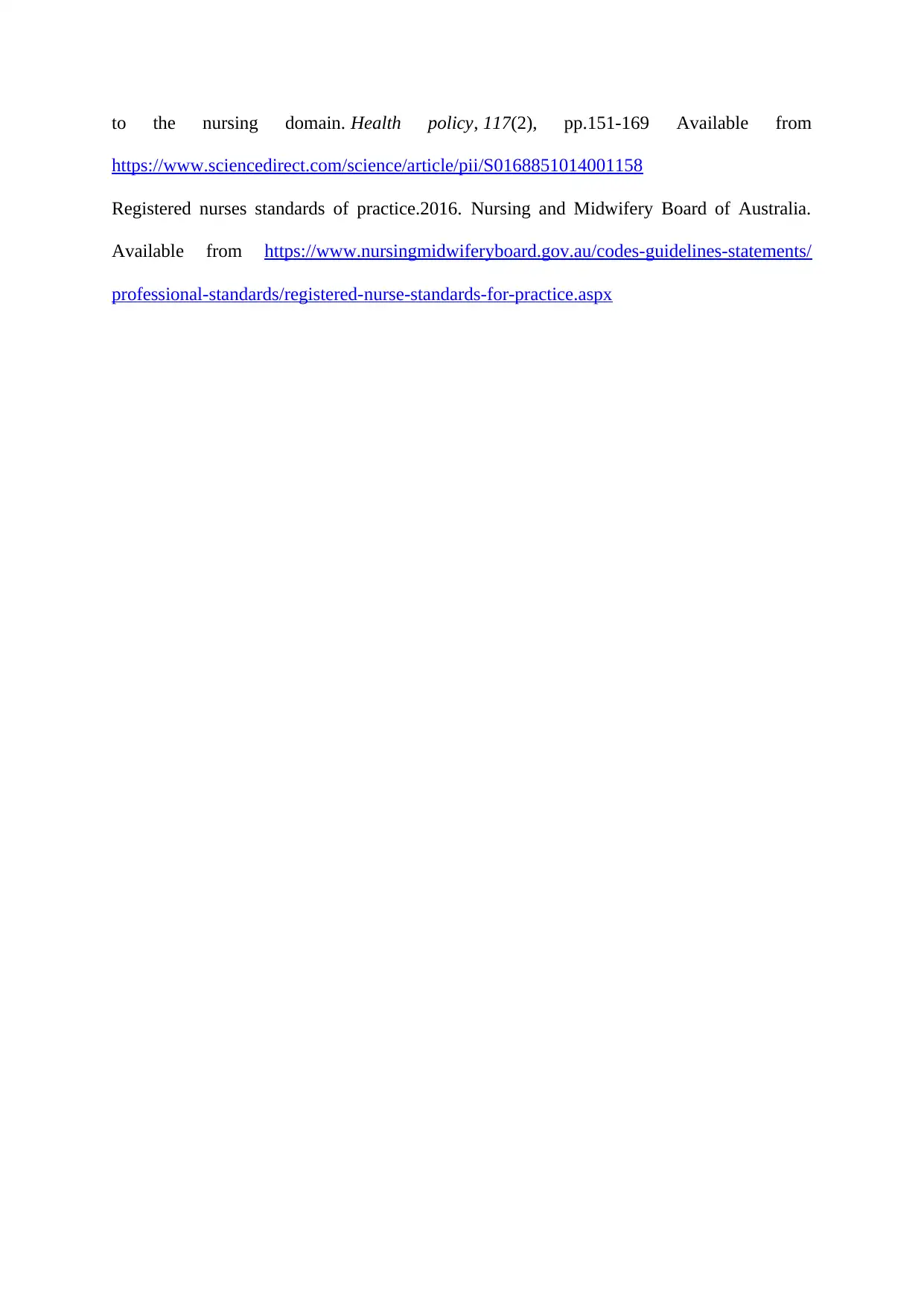
to the nursing domain. Health policy, 117(2), pp.151-169 Available from
https://www.sciencedirect.com/science/article/pii/S0168851014001158
Registered nurses standards of practice.2016. Nursing and Midwifery Board of Australia.
Available from https://www.nursingmidwiferyboard.gov.au/codes-guidelines-statements/
professional-standards/registered-nurse-standards-for-practice.aspx
https://www.sciencedirect.com/science/article/pii/S0168851014001158
Registered nurses standards of practice.2016. Nursing and Midwifery Board of Australia.
Available from https://www.nursingmidwiferyboard.gov.au/codes-guidelines-statements/
professional-standards/registered-nurse-standards-for-practice.aspx
1 out of 9
Related Documents
Your All-in-One AI-Powered Toolkit for Academic Success.
+13062052269
info@desklib.com
Available 24*7 on WhatsApp / Email
![[object Object]](/_next/static/media/star-bottom.7253800d.svg)
Unlock your academic potential
© 2024 | Zucol Services PVT LTD | All rights reserved.





